Shouwei Ruan
From reactive to cognitive: brain-inspired spatial intelligence for embodied agents
Aug 24, 2025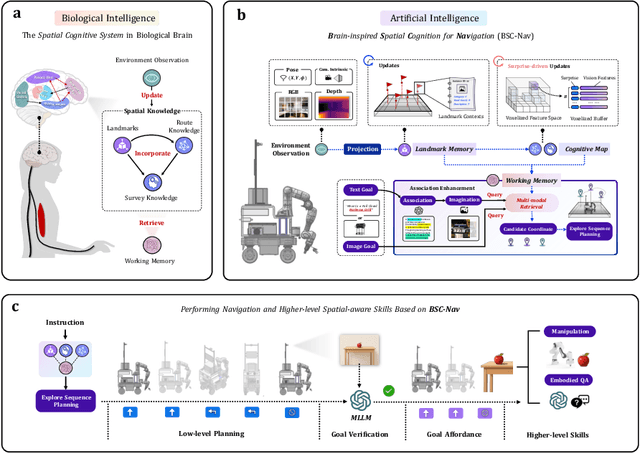
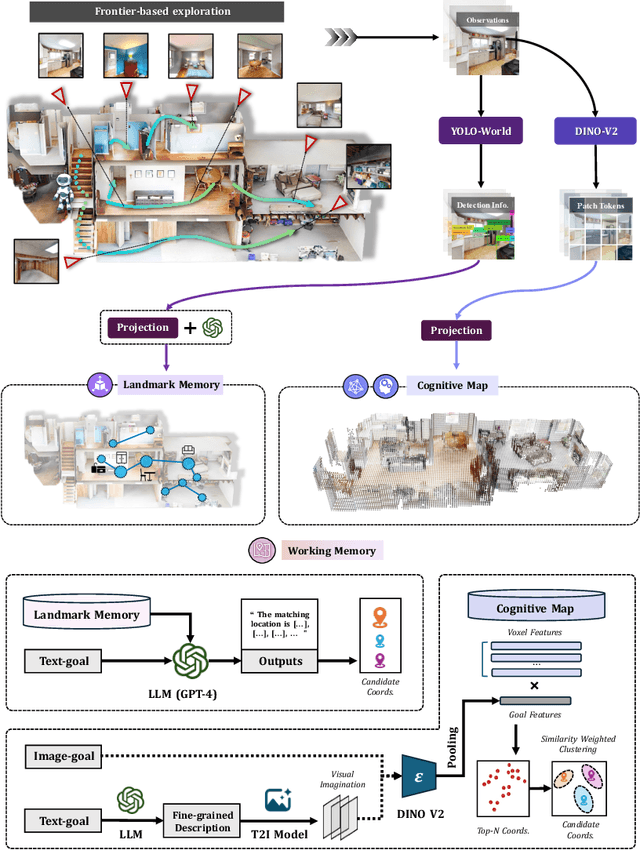
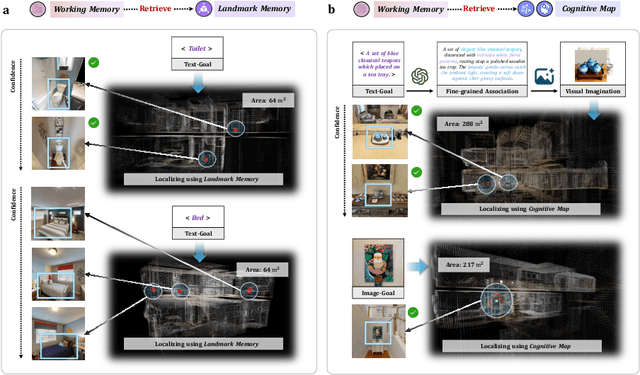
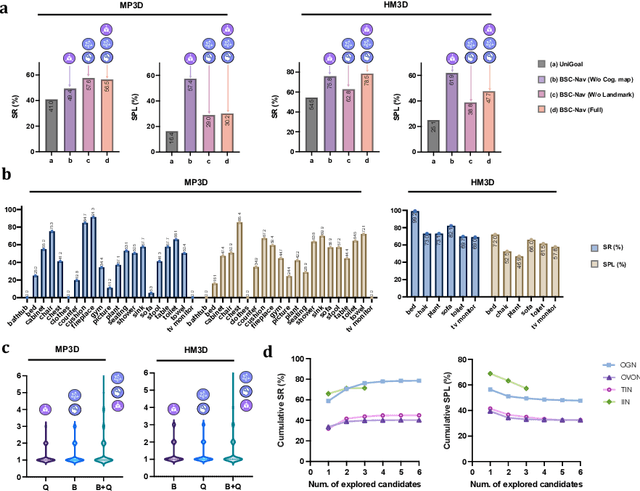
Abstract:Spatial cognition enables adaptive goal-directed behavior by constructing internal models of space. Robust biological systems consolidate spatial knowledge into three interconnected forms: \textit{landmarks} for salient cues, \textit{route knowledge} for movement trajectories, and \textit{survey knowledge} for map-like representations. While recent advances in multi-modal large language models (MLLMs) have enabled visual-language reasoning in embodied agents, these efforts lack structured spatial memory and instead operate reactively, limiting their generalization and adaptability in complex real-world environments. Here we present Brain-inspired Spatial Cognition for Navigation (BSC-Nav), a unified framework for constructing and leveraging structured spatial memory in embodied agents. BSC-Nav builds allocentric cognitive maps from egocentric trajectories and contextual cues, and dynamically retrieves spatial knowledge aligned with semantic goals. Integrated with powerful MLLMs, BSC-Nav achieves state-of-the-art efficacy and efficiency across diverse navigation tasks, demonstrates strong zero-shot generalization, and supports versatile embodied behaviors in the real physical world, offering a scalable and biologically grounded path toward general-purpose spatial intelligence.
Mitigating Overthinking in Large Reasoning Models via Manifold Steering
May 28, 2025Abstract:Recent advances in Large Reasoning Models (LRMs) have demonstrated remarkable capabilities in solving complex tasks such as mathematics and coding. However, these models frequently exhibit a phenomenon known as overthinking during inference, characterized by excessive validation loops and redundant deliberation, leading to substantial computational overheads. In this paper, we aim to mitigate overthinking by investigating the underlying mechanisms from the perspective of mechanistic interpretability. We first showcase that the tendency of overthinking can be effectively captured by a single direction in the model's activation space and the issue can be eased by intervening the activations along this direction. However, this efficacy soon reaches a plateau and even deteriorates as the intervention strength increases. We therefore systematically explore the activation space and find that the overthinking phenomenon is actually tied to a low-dimensional manifold, which indicates that the limited effect stems from the noises introduced by the high-dimensional steering direction. Based on this insight, we propose Manifold Steering, a novel approach that elegantly projects the steering direction onto the low-dimensional activation manifold given the theoretical approximation of the interference noise. Extensive experiments on DeepSeek-R1 distilled models validate that our method reduces output tokens by up to 71% while maintaining and even improving the accuracy on several mathematical benchmarks. Our method also exhibits robust cross-domain transferability, delivering consistent token reduction performance in code generation and knowledge-based QA tasks. Code is available at: https://github.com/Aries-iai/Manifold_Steering.
Breaking the Ceiling: Exploring the Potential of Jailbreak Attacks through Expanding Strategy Space
May 28, 2025Abstract:Large Language Models (LLMs), despite advanced general capabilities, still suffer from numerous safety risks, especially jailbreak attacks that bypass safety protocols. Understanding these vulnerabilities through black-box jailbreak attacks, which better reflect real-world scenarios, offers critical insights into model robustness. While existing methods have shown improvements through various prompt engineering techniques, their success remains limited against safety-aligned models, overlooking a more fundamental problem: the effectiveness is inherently bounded by the predefined strategy spaces. However, expanding this space presents significant challenges in both systematically capturing essential attack patterns and efficiently navigating the increased complexity. To better explore the potential of expanding the strategy space, we address these challenges through a novel framework that decomposes jailbreak strategies into essential components based on the Elaboration Likelihood Model (ELM) theory and develops genetic-based optimization with intention evaluation mechanisms. To be striking, our experiments reveal unprecedented jailbreak capabilities by expanding the strategy space: we achieve over 90% success rate on Claude-3.5 where prior methods completely fail, while demonstrating strong cross-model transferability and surpassing specialized safeguard models in evaluation accuracy. The code is open-sourced at: https://github.com/Aries-iai/CL-GSO.
Enhancing Adversarial Robustness of Vision Language Models via Adversarial Mixture Prompt Tuning
May 23, 2025Abstract:Large pre-trained Vision Language Models (VLMs) have excellent generalization capabilities but are highly susceptible to adversarial examples, presenting potential security risks. To improve the robustness of VLMs against adversarial examples, adversarial prompt tuning methods are proposed to align the text feature with the adversarial image feature without changing model parameters. However, when facing various adversarial attacks, a single learnable text prompt has insufficient generalization to align well with all adversarial image features, which finally leads to the overfitting phenomenon. To address the above challenge, in this paper, we empirically find that increasing the number of learned prompts can bring more robustness improvement than a longer prompt. Then we propose an adversarial tuning method named Adversarial Mixture Prompt Tuning (AMPT) to enhance the generalization towards various adversarial attacks for VLMs. AMPT aims to learn mixture text prompts to obtain more robust text features. To further enhance the adaptability, we propose a conditional weight router based on the input adversarial image to predict the mixture weights of multiple learned prompts, which helps obtain sample-specific aggregated text features aligning with different adversarial image features. A series of experiments show that our method can achieve better adversarial robustness than state-of-the-art methods on 11 datasets under different experimental settings.
Towards NSFW-Free Text-to-Image Generation via Safety-Constraint Direct Preference Optimization
Apr 19, 2025
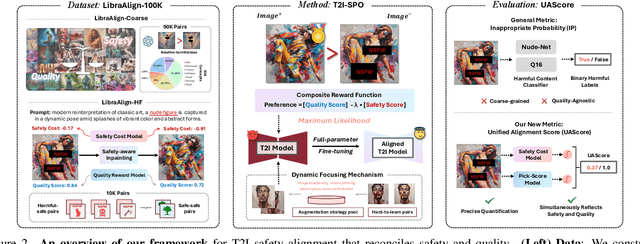

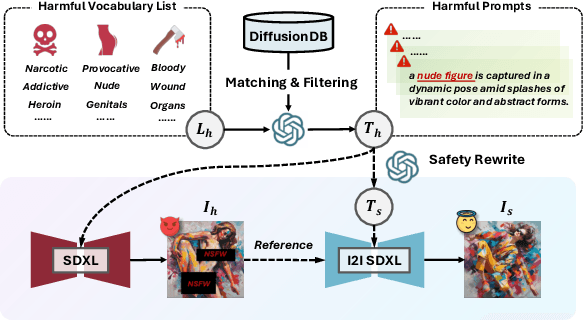
Abstract:Ensuring the safety of generated content remains a fundamental challenge for Text-to-Image (T2I) generation. Existing studies either fail to guarantee complete safety under potentially harmful concepts or struggle to balance safety with generation quality. To address these issues, we propose Safety-Constrained Direct Preference Optimization (SC-DPO), a novel framework for safety alignment in T2I models. SC-DPO integrates safety constraints into the general human preference calibration, aiming to maximize the likelihood of generating human-preferred samples while minimizing the safety cost of the generated outputs. In SC-DPO, we introduce a safety cost model to accurately quantify harmful levels for images, and train it effectively using the proposed contrastive learning and cost anchoring objectives. To apply SC-DPO for effective T2I safety alignment, we constructed SCP-10K, a safety-constrained preference dataset containing rich harmful concepts, which blends safety-constrained preference pairs under both harmful and clean instructions, further mitigating the trade-off between safety and sample quality. Additionally, we propose a Dynamic Focusing Mechanism (DFM) for SC-DPO, promoting the model's learning of difficult preference pair samples. Extensive experiments demonstrate that SC-DPO outperforms existing methods, effectively defending against various NSFW content while maintaining optimal sample quality and human preference alignment. Additionally, SC-DPO exhibits resilience against adversarial prompts designed to generate harmful content.
When Lighting Deceives: Exposing Vision-Language Models' Illumination Vulnerability Through Illumination Transformation Attack
Mar 10, 2025



Abstract:Vision-Language Models (VLMs) have achieved remarkable success in various tasks, yet their robustness to real-world illumination variations remains largely unexplored. To bridge this gap, we propose \textbf{I}llumination \textbf{T}ransformation \textbf{A}ttack (\textbf{ITA}), the first framework to systematically assess VLMs' robustness against illumination changes. However, there still exist two key challenges: (1) how to model global illumination with fine-grained control to achieve diverse lighting conditions and (2) how to ensure adversarial effectiveness while maintaining naturalness. To address the first challenge, we innovatively decompose global illumination into multiple parameterized point light sources based on the illumination rendering equation. This design enables us to model more diverse lighting variations that previous methods could not capture. Then, by integrating these parameterized lighting variations with physics-based lighting reconstruction techniques, we could precisely render such light interactions in the original scenes, finally meeting the goal of fine-grained lighting control. For the second challenge, by controlling illumination through the lighting reconstrution model's latent space rather than direct pixel manipulation, we inherently preserve physical lighting priors. Furthermore, to prevent potential reconstruction artifacts, we design additional perceptual constraints for maintaining visual consistency with original images and diversity constraints for avoiding light source convergence. Extensive experiments demonstrate that our ITA could significantly reduce the performance of advanced VLMs, e.g., LLaVA-1.6, while possessing competitive naturalness, exposing VLMS' critical illuminiation vulnerabilities.
AdvDreamer Unveils: Are Vision-Language Models Truly Ready for Real-World 3D Variations?
Dec 04, 2024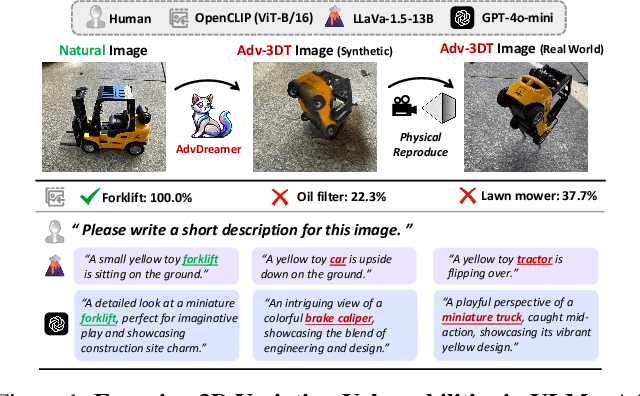
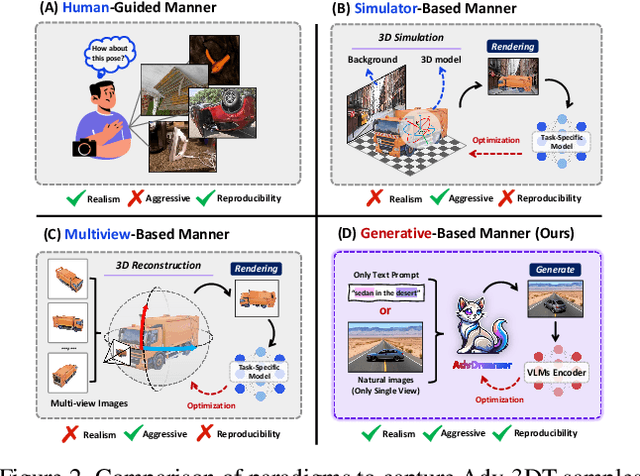
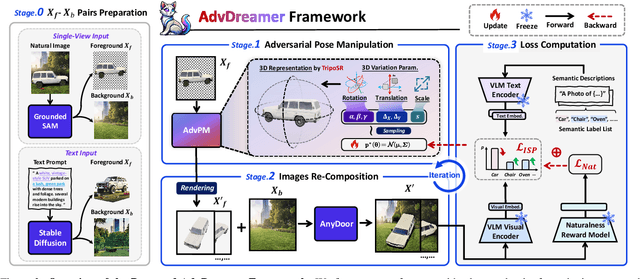
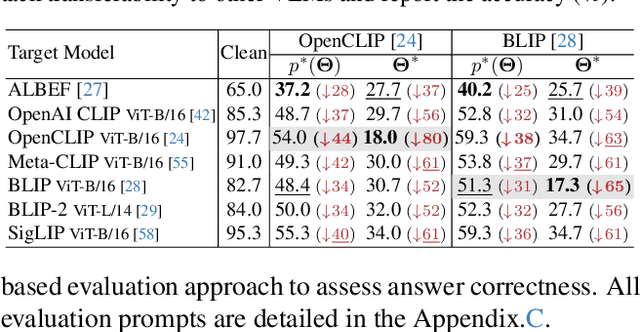
Abstract:Vision Language Models (VLMs) have exhibited remarkable generalization capabilities, yet their robustness in dynamic real-world scenarios remains largely unexplored. To systematically evaluate VLMs' robustness to real-world 3D variations, we propose AdvDreamer, the first framework that generates physically reproducible adversarial 3D transformation (Adv-3DT) samples from single-view images. AdvDreamer integrates advanced generative techniques with two key innovations and aims to characterize the worst-case distributions of 3D variations from natural images. To ensure adversarial effectiveness and method generality, we introduce an Inverse Semantic Probability Objective that executes adversarial optimization on fundamental vision-text alignment spaces, which can be generalizable across different VLM architectures and downstream tasks. To mitigate the distribution discrepancy between generated and real-world samples while maintaining physical reproducibility, we design a Naturalness Reward Model that provides regularization feedback during adversarial optimization, preventing convergence towards hallucinated and unnatural elements. Leveraging AdvDreamer, we establish MM3DTBench, the first VQA dataset for benchmarking VLMs' 3D variations robustness. Extensive evaluations on representative VLMs with diverse architectures highlight that 3D variations in the real world may pose severe threats to model performance across various tasks.
OODFace: Benchmarking Robustness of Face Recognition under Common Corruptions and Appearance Variations
Dec 03, 2024



Abstract:With the rise of deep learning, facial recognition technology has seen extensive research and rapid development. Although facial recognition is considered a mature technology, we find that existing open-source models and commercial algorithms lack robustness in certain real-world Out-of-Distribution (OOD) scenarios, raising concerns about the reliability of these systems. In this paper, we introduce OODFace, which explores the OOD challenges faced by facial recognition models from two perspectives: common corruptions and appearance variations. We systematically design 30 OOD scenarios across 9 major categories tailored for facial recognition. By simulating these challenges on public datasets, we establish three robustness benchmarks: LFW-C/V, CFP-FP-C/V, and YTF-C/V. We then conduct extensive experiments on 19 different facial recognition models and 3 commercial APIs, along with extended experiments on face masks, Vision-Language Models (VLMs), and defense strategies to assess their robustness. Based on the results, we draw several key insights, highlighting the vulnerability of facial recognition systems to OOD data and suggesting possible solutions. Additionally, we offer a unified toolkit that includes all corruption and variation types, easily extendable to other datasets. We hope that our benchmarks and findings can provide guidance for future improvements in facial recognition model robustness.
Real-world Adversarial Defense against Patch Attacks based on Diffusion Model
Sep 14, 2024Abstract:Adversarial patches present significant challenges to the robustness of deep learning models, making the development of effective defenses become critical for real-world applications. This paper introduces DIFFender, a novel DIFfusion-based DeFender framework that leverages the power of a text-guided diffusion model to counter adversarial patch attacks. At the core of our approach is the discovery of the Adversarial Anomaly Perception (AAP) phenomenon, which enables the diffusion model to accurately detect and locate adversarial patches by analyzing distributional anomalies. DIFFender seamlessly integrates the tasks of patch localization and restoration within a unified diffusion model framework, enhancing defense efficacy through their close interaction. Additionally, DIFFender employs an efficient few-shot prompt-tuning algorithm, facilitating the adaptation of the pre-trained diffusion model to defense tasks without the need for extensive retraining. Our comprehensive evaluation, covering image classification and face recognition tasks, as well as real-world scenarios, demonstrates DIFFender's robust performance against adversarial attacks. The framework's versatility and generalizability across various settings, classifiers, and attack methodologies mark a significant advancement in adversarial patch defense strategies. Except for the popular visible domain, we have identified another advantage of DIFFender: its capability to easily expand into the infrared domain. Consequently, we demonstrate the good flexibility of DIFFender, which can defend against both infrared and visible adversarial patch attacks alternatively using a universal defense framework.
Omniview-Tuning: Boosting Viewpoint Invariance of Vision-Language Pre-training Models
Apr 18, 2024



Abstract:Vision-Language Pre-training (VLP) models like CLIP have achieved remarkable success in computer vision and particularly demonstrated superior robustness to distribution shifts of 2D images. However, their robustness under 3D viewpoint variations is still limited, which can hinder the development for real-world applications. This paper successfully addresses this concern while keeping VLPs' original performance by breaking through two primary obstacles: 1) the scarcity of training data and 2) the suboptimal fine-tuning paradigms. To combat data scarcity, we build the Multi-View Caption (MVCap) dataset -- a comprehensive collection of over four million multi-view image-text pairs across more than 100K objects, providing more potential for VLP models to develop generalizable viewpoint-invariant representations. To address the limitations of existing paradigms in performance trade-offs and training efficiency, we design a novel fine-tuning framework named Omniview-Tuning (OVT). Specifically, OVT introduces a Cross-Viewpoint Alignment objective through a minimax-like optimization strategy, which effectively aligns representations of identical objects from diverse viewpoints without causing overfitting. Additionally, OVT fine-tunes VLP models in a parameter-efficient manner, leading to minimal computational cost. Extensive experiments on various VLP models with different architectures validate that OVT significantly improves the models' resilience to viewpoint shifts and keeps the original performance, establishing a pioneering standard for boosting the viewpoint invariance of VLP models.
 Add to Chrome
Add to Chrome Add to Firefox
Add to Firefox Add to Edge
Add to Edge